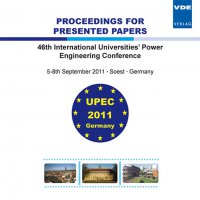Numerical Simulation of a Transmission Line Fault Location and Identification Methodology in the Presence of Superfluous Noise
Konferenz: UPEC 2011 - 46th International Universities' Power Engineering Conference
05.09.2011 - 08.09.2011 in Soest, Germany
Tagungsband: UPEC 2011
Seiten: 6Sprache: EnglischTyp: PDF
Persönliche VDE-Mitglieder erhalten auf diesen Artikel 10% Rabatt
Autoren:
Healy, Caroline; Guinee, Richard A. (Department of Electrical Engineering, Cork Institute of Technology, Cork, Ireland)
Inhalt:
This paper exhibits an innovative pulse echo test methodology which encompasses the deployment of a Pseudorandom Binary Sequence (PRBS) excitation as a viable competitive alternative to traditional Time Domain Reflectometry (TDR) implemented in transmission line fault identification and location. The fundamental element of this system identification technique resides in the unique characteristic signature produced in the presence of a mismatched or faulty termination. This characteristic signature results as a consequence of the Cross Correlation (CCR) of both the induced fault echo response and PRBS test input stimulus. The distinctive manifestation of the delayed CCR profile signature facilitates the identification of a fault present, if any and in addition once prior knowledge of the velocity of propagation of the signal over the transmission link has been determined the fault location can thus be established from the inherent 'time lag' between both the test stimulus ACF and CCR profile peaks. The PRBS possesses a wideband power spectrum which in essence is considered to be white noise like in nature. This attribute fundamentally allows the Cross Correlation process to be undertaken over numerous cycles at low amplitudes in the presence of normal online signal traffic and extraneous noise present which are progressively filtered out as the PRBS stimulus is uncorrelated with these, ensuring that fault resolution and identification is achieved with negligible interference to the normal online signal traffic. This paper presents a high frequency co-axial transmission line model for behavioural simulation with PRBS stimulus injection under various known load terminations for test concept validation. Results are also presented to illustrate the effectiveness of multiple PRBS cycle correlation in the presence of superfluous noise with known load terminations and further findings which clearly exemplify the reduction in the presence noise as correlation number cycles increase. Derived parameter estimates from simulated model results, of the reflection coefficients and resulting fault termination resistances with Voltage Standing Wave Ratio (VSWR) are in close proximity with theoretical calculations thus further validating the accuracy of the PRBS test technique.


